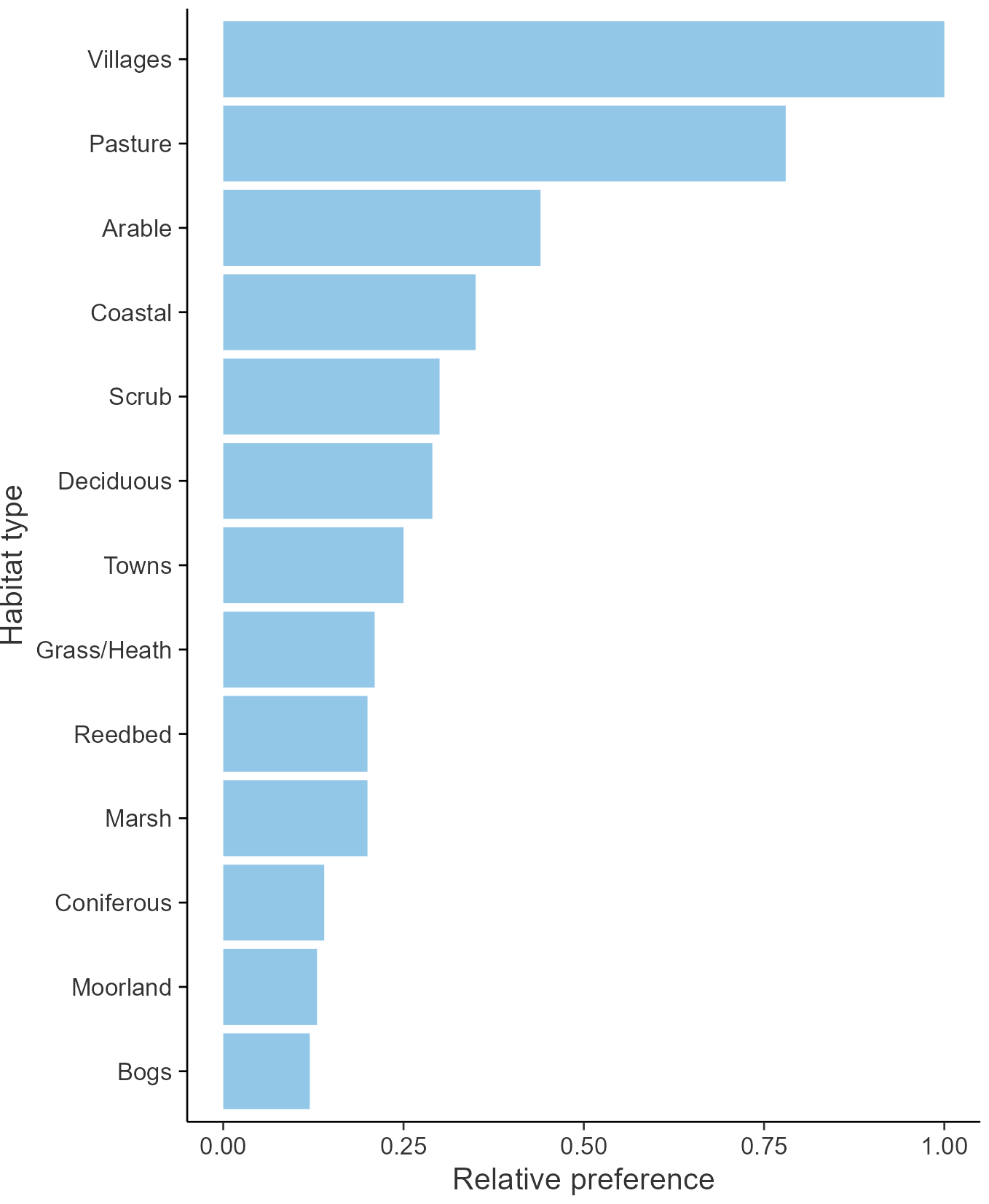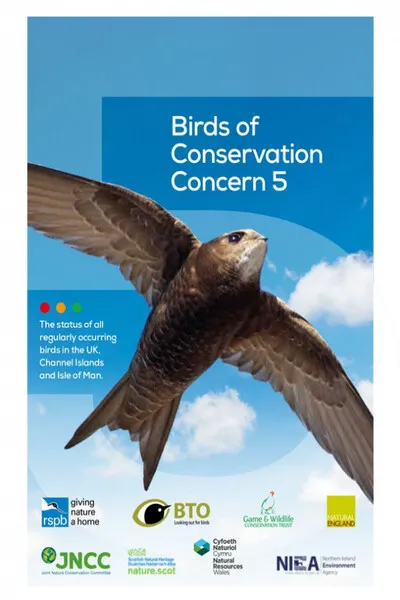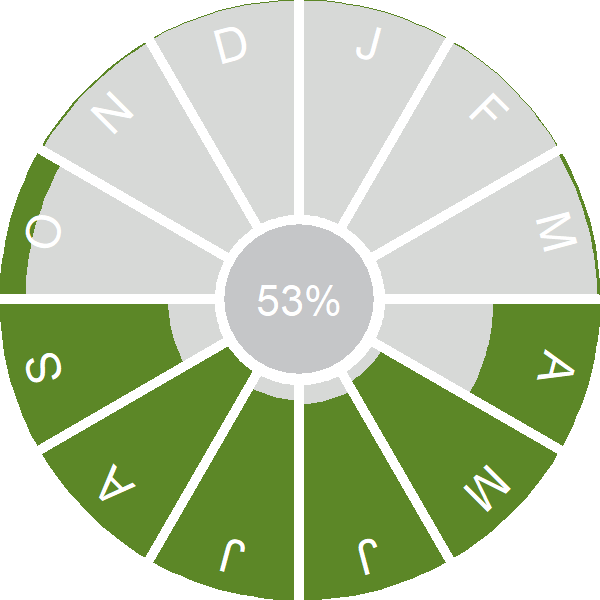Swallow

Introduction
The sight of an early spring Swallow with its long, forked tail, red throat and white belly signals that summer is not far away.
A long-distance migrant, many of our Swallows spend the winter months in South Africa. The first Swallows begin to arrive in the UK during March and stay here into October. In recent years a small number of birds have attempted, in some years successfully, to overwinter in the UK.
The Swallow can be found across Britain & Ireland and can be seen flying at speed just inches above its favoured grassland feeding habitat as it snatches its insect prey. UK Swallow have fluctuated sharply in recent decades, with declines seen in England, Wales, Scotland and Northern Ireland since about 2010.
- Our Trends Explorer gives you the latest insight into how this species' population is changing.

Key Stats
Identification
ID Videos
This section features BTO training videos headlining this species, or featuring it as a potential confusion species.
Hirundines & Swift
GBW: Swift, Swallow and House Martin
Songs and Calls
Song:
Call:
Alarm call:
Status and Trends
Conservation Status
Population Change
Swallow was originally amber listed partly on the strength of a decline on CBC plots in the early 1980s, but later modelling of UK population change from CBC gave evidence of fluctuations but not of long-term decline (Robinson et al. 2003). Nevertheless, the species continued to qualify for amber listing through its 'depleted' status across the European continent (BirdLife International 2004). Following further review of its status in Europe, the species was moved to the UK green list in 2015 (Eaton et al. 2015). The trend has been broadly stable across Europe since 1980 (PECBMS: PECBMS 2020a>).
BBS data suggest shallow increases occurred in England, Scotland and Wales from 1995 until around 2010. The BBS map of change in relative density between 1994-96 and 2007-09, however, indicates that decreases had occurred during that period in Northern Ireland and in eastern coastal regions of Britain, with the strongest increases in western Britain. More recent BBS records indicate that declines have occurred in all four UK countries over the last ten years, reversing the earlier increases.
Distribution
Recorded breeding in 95% of 10-km squares, the Swallow has the most extensive distribution of any summer migrant in Britain & Ireland. It is absent only from a few areas of northern Scotland and from central London. It occurs at high densities throughout Ireland.
Occupied 10-km squares in UK
or view it on Bird Atlas Mapstore.
or view it on Bird Atlas Mapstore.
European Distribution Map
Distribution Change
Overall range size has changed little over the course of the atlases, although gains point to a small northward expansion.
Change in occupied 10-km squares in the UK
or view it on Bird Atlas Mapstore.
or view it on Bird Atlas Mapstore.
Seasonality
Swallows usually arrive from April onwards with birds beginning to depart in September; stragglers may be present into October.
Weekly pattern of occurrence
The graph shows when the species is present in the UK, with taller bars indicating a higher likelihood of encountering the species in appropriate regions and habitats.

Migrant arrival timing
Habitats
Breeding season habitats
Relative frequency by habitat
The graph shows the habitats occupied in the breeding season, with the most utilised habitats shown at the top. Bars of similar size indicate the species is equally likely to be recorded in those habitats.

Movement
Britain & Ireland movement
Foreign locations of birds ringed or recovered in Britain & Ireland
Dots show the foreign destinations of birds ringed in Britain & Ireland, and the origins of birds ringed overseas that were subsequently recaptured, resighted or found dead in Britain & Ireland. Dot colours indicate the time of year that the species was present at the location.
- Winter (Nov-Feb)
- Spring (Mar-Apr)
- Summer (May-Jul)
- Autumn (Aug-Oct)

European movements
EuroBirdPortal uses birdwatcher's records, such as those logged in BirdTrack to map the flows of birds as they arrive and depart Europe. See maps for this species here.
The Eurasian-African Migration Atlas shows movements of individual birds ringed or recovered in Europe. See maps for this species here.
Biology
Productivity and Nesting
Nesting timing
Egg measurements
Clutch Size
Incubation
Fledging
Survival and Longevity
Survival is shown as the proportion of birds surviving from one year to the next and is derived from bird ringing data. It can also be used to estimate how long birds typically live.
View number ringed each year in the Online Ringing Report.
lifespan
Survival of adults
Survival of juveniles
Biometrics
Wing length and body weights are from live birds (source).
Wing length
Body weight
Ring Size
Classification, names and codes
Classification and Codes
- Order: Passeriformes
- Family: Hirundinidae
- Scientific name: Hirundo rustica
- Authority: Linnaeus, 1758
- BTO 2-letter code: SL
- BTO 5-letter code: SWALL
- Euring code number: 9920
Alternate species names
- Catalan: oreneta comuna
- Czech: vlaštovka obecná
- Danish: Landsvale
- Dutch: Boerenzwaluw
- Estonian: suitsupääsuke
- Finnish: haarapääsky
- French: Hirondelle rustique
- Gaelic: Gobhlan-gaoithe
- German: Rauchschwalbe
- Hungarian: füsti fecske
- Icelandic: Landsvala
- Irish: Fáinleog
- Italian: Rondine
- Latvian: bezdeliga
- Lithuanian: šelmenine kregžde
- Norwegian: Låvesvale
- Polish: dymówka
- Portuguese: andorinha-de-bando / andorinha-das-chaminés
- Slovak: lastovicka obycajná
- Slovenian: kmecka lastovka
- Spanish: Golondrina común
- Swedish: ladusvala
- Welsh: Gwennol
Research
Causes of Change and Solutions
Causes of change
The reasons for change are currently unclear. Although agricultural intensification is likely to be a primary driver, over-winter survival and changes in habitat on the breeding grounds may both be having an effect.
Further information on causes of change
Population fluctuations are most strongly related to variable levels of survival (Robinson et al. 2014), most likely on their wintering grounds (Baillie & Peach 1992). More particularly, annual population change has been shown to be correlated with rainfall in the western Sahel prior to the birds' spring passage through West Africa, but with neither cattle numbers nor nest-site availability in the UK (Robinson et al. 2003). Annual survival rates from RAS sites in the UK for 1998-2004 were correlated positively with mean monthly rainfall during the early austral summer in southern Africa (Robinson et al. 2008). A review of research into threats to adult survival of several hirundine species, including Swallow, identified weather conditions throughout the annual cycle as a key threat (Imlay & Leonard 2019). There is also evidence suggesting that weather conditions experienced by Swallows during winter may have carry over effects which could affect breeding productivity the following summer (Saino et al. 2012).
It is likely that, in eastern parts of the UK, the loss of livestock farming and grazed grassland, together with arable intensification, has caused the Swallow population to decline, while an increase in the area of pasture in the west and north has promoted a population increase which apparently has more than compensated for declines elsewhere (Evans & Robinson 2004). A link between regional changes in the availability of preferred feeding habitats and the regional patterns of UK population change again suggests that habitat change on the breeding grounds may explain population trend, at least partly (Henderson et al. 2007). Brood size increased up to the late 1980s, however current data show no difference in brood size compared to the late 1960s, while nest losses have increased and the number of fledglings per breeding attempt shows no trend. A Danish study over 22 years found that the number of nesting pairs and the rate at which birds made feeding visits to nests declined in parallel with declines in insect abundance (Moller 2019); however numbers of fledglings were not counted by this study. Further evidence is therefore needed to confirm whether agricultural intensification and changes in insect abundance may have been sufficient to directly affect nest productivity and hence cause population changes at local and wider scales.
Climatic warming is leading to an earlier start to the breeding season for European Swallows, and analysis of phenological data has found that the arrival date in the UK has advanced, between the 1960s and 2000s, by 15 days (Newson et al. 2016), with the laying date also advancing (see above). Facey et al. (2020) found that nestling mass was negatively correlated with temperature, although the relationship with other weather conditions was complex and fledgling body mass was less sensitive to weather, hence the lower nestling body mass does not necessarily have any subsequent effect on juvenile survival and hence on population trends. However, Turner (2009) found that there has been increased chick mortality in hot, dry summers and reduced post-fledging survival because of poor conditions for birds migrating through North Africa. A study in eastern Germany also highlighted reduced breeding success despite earlier breeding, and suggested that a mismatch between local and large-scale climatic changes may mean that, for this species, earlier breeding was not sufficient in that region to respond to climate change (Grimm et al. 2015).
Information about conservation actions
The decline of the Swallow in some parts of the UK may relate to agricultural intensification and changes of land use. There is evidence from several studies in Europe, including one in the UK, that the retention of cattle for meat or dairy farming may improve breeding performance and colony size and buffer Swallow declines ( Moller 2001 ; Evans et al. 2007; Gruebler et al. 2010; Ambrosini et al. 2012; Sicurella et al. 2014), with the presence of manure heaps also important ( Gruebler et al. 2010), and the presence of greater numbers of hayfields within 200 m of the colony increasing colony size at farms without livestock (Sicurella et al. 2014).
Artificial nests have also been suggested as a possible conservation option. In a study in Denmark, artificial nests had a low predation rate which was similar to natural nests, and showed higher breeding productivity. The author speculated that this could be due to the saving of energy and time costs from nest construction ( Teglhoj et al. 2018).
Publications (3)
Spatial variation in spring arrival patterns of Afro-Palearctic bird migration across Europe
Author: Border, J.A., Boersch-Supan, P., Pearce-Higgins, J.W., Hewson, C., Howard, C., Stephens, P.A., Willis, S.G., Houston, A., Gargallo, G. & Baillie, S.R.
Published: 2024
The timing of migrant birds’ arrival on the breeding grounds, or spring arrival, can affect their survival and breeding success. The optimal time for spring arrival involves trade-offs between various factors, including the availability of food and suitable breeding habitat, and the risks of severe weather. Due to climate change, the timing of spring emergence has advanced for many plants and insects which affects the timing of maximum food availability for migratory birds in turn. The degree to which different bird species can adapt to this varies. Understanding the factors that influence spring arrival in different species can help us to predict how they may respond to future changes in climate.
02.05.24
Papers

The status of our bird populations: the fifth Birds of Conservation Concern in the United Kingdom, Channel Islands and Isle of Man and second IUCN Red List assessment of extinction risk for Great Britain
Author: Stanbury, A.J., Eaton, M.A., Aebischer, N.J., Balmer, D., Brown, A.F., Douse, A., Lindley, P., McCulloch, N., Noble, D.G. & Win, I.
Published: 2021
Commonly referred to as the UK Red List for birds, this is the fifth review of the status of birds in the UK, Channel Islands and Isle of Man, published in December 2021 as Birds of Conservation Concern 5 (BOCC5). This updates the last assessment in 2015. Using standardised criteria, experts from a range of bird NGOs, including BTO, assessed 245 species with breeding, passage or wintering populations in the UK and assigned each to the Red, Amber or Green Lists of conservation concern.
01.12.21
Reports Birds of Conservation Concern

Flight Lines: Tracking the wonders of bird migration
Author: Mike Toms
Published: 2017
This stunning new book brings together the latest research findings, delivered through an accessible and engaging narrative by the BTO's Mike Toms, with the wonderful artwork generated through the BTO/SWLA Flight Lines project. If you have an interest in our summer migrants, then you'll welcome this fantastic opportunity to discover their stories through art and the written word.
21.08.17
Books and guides

